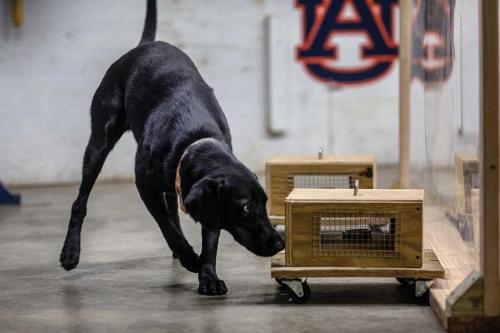Trained dogs are incredible chemical sensors, far better at detecting explosives, narcotics and other substances than even the most advanced technological device. But one challenge is that dogs have to be trained, and training them with real hazardous substances can be inconvenient and dangerous.
Scientists at NIST (the US National Institute of Standards and Technology) have been working to solve this problem using polydimethylsiloxane (PDMS). PDMS absorbs odours and releases them slowly over time. Enclose PDMS in a container with an explosive or narcotic for a few weeks until it absorbs the odours, and you can then use it to safely train dogs to detect the real thing.
But a few weeks is a long time, and now NIST researchers have developed a faster way to infuse PDMS with vapours. In Forensic Chemistry (doi.org/10.1016/j.forc.2020.100290), they describe warming compounds found in explosives, causing them to release vapours more quickly, then capturing those vapours with PDMS that is maintained at a lower temperature, which allows it to absorb vapours more readily. This two-temperature method cut the time it took to ‘charge’ PDMS training aids from a few weeks to a few days.
‘That time savings can be critical’, said NIST research chemist Bill MacCrehan. ‘If terrorists are using a new type of explosive, you don’t want to wait a month for the training aids to be ready.’
MacCrehan infused PDMS with vapours from dinitrotoluene (DNT), which is a low-level contaminant present in TNT explosives but the main odorant that dogs respond to when detecting TNT. He also infused PDMS with vapours from a small quantity of TNT. Co-authors at the Auburn University College of Veterinary Medicine then demonstrated that trained detection dogs responded to the DNT-infused PDMS training aids as if they were real TNT.
While this study focused on DNT as a proof of concept, MacCrehan said he believes the two-temperature method will also work with other explosives and with narcotics such as fentanyl. Some forms of fentanyl are so potent that inhaling a small amount can be harmful or fatal to humans and dogs. But by controlling how much vapour the PDMS absorbs, it should be possible to create safe training aids for fentanyl.
Other safe training aids already exist. Some are prepared by dissolving explosives and applying the solution to glass beads, for example. ‘But most have not been widely accepted in the canine detection community because their effectiveness has not been proven’, said Paul Waggoner, a co-author and co-director of Auburn’s Canine Performance Sciences Program. ‘If you put an explosive in a solvent, the dogs might actually be detecting the solvent, not the explosive.’
MacCrehan devised a PDMS ‘charging station’ with a hot plate on one side and a cooling plate on the other. He prepared various samples by placing the DNT on the hot side, where the chemical was warmed to 30–35°C – well below the temperature that would cause TNT to detonate. The PDMS was kept at 20°C on the other side of the charging station.
MacCrehan loaded the DNT-infused PDMS samples, which hold their charge for up to a few months, into perforated metal cans. He also loaded several cans with blanks – PDMS samples to which no vapours were added. He labelled the cans with codes and shipped them to Auburn University.
At Auburn, researchers had trained six labrador retrievers to detect TNT using real TNT explosives. They then conducted a study to determine if the dogs would alert to the PDMS in the NIST samples as if it were real TNT.
This study was ‘double blind’: neither the dog handlers nor the note-takers who scored the dogs’ responses knew which containers underwent which preparation. This is important because dogs are keenly attuned to the body language of their handlers. If the handlers knew which samples were prepared with DNT, they might inadvertently cue the dogs with the direction of their gaze, a subtle shift in body position or some other subconscious gesture. And if the note-takers knew which samples were which, they might over-interpret the dogs’ responses.
The dogs alerted to all the DNT-infused PDMS samples. They did not alert to the blanks, meaning that they were responding to the DNT, not to the PDMS itself.
The dogs did not respond as consistently to PDMS that was infused with limited quantities of TNT. However, MacCrehan explained that the very small amounts of TNT he used for this purpose may not have contained sufficient amounts of DNT to fully infuse the samples.
MacCrehan will experiment with ways to safely prepare PDMS training aids for the improvised explosives TATP and HMTD, which are extremely unstable and detonate easily, so having safe training aids for them will be especially useful.



